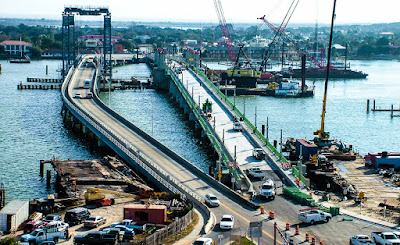The Bridge of Lions, an Architectural Work of Art
As with all things in the architecturally stunning city of St. Augustine, the Bridge of Lions is more than just a way to get from downtown to Anastasia Island. It's a work of art in and of itself, and that's not by accident.
This bridge was prone to breakdowns, however, so in the 1920s, a man by the name of Henry Rodenbaugh stepped up to design a more reliable bridge. The Florida land boom was erupting by then, and with the advent and popularity of more affordable automobiles, tourism was expanding as well. As a result, St. Augustine was in need of a more dependable means of passage across the inter-coastal highway.
Construction began in 1925 and was completed in 1927. At 1,545 feet, it spanned the Matanzas River and connected Anastasia Island and the city of St. Augustine. A double-leaf bascule bridge, it opens to allow passage of watercraft too tall to pass below. Although the bridge was initially intended to be two lanes wide, the land boom combined with popularity of the area with tourists led to the decision to make the bridge four lanes wide.
They flank the west end of the bridge to symbolize guardianship of the city. The statues were made by Romanelli Studios in Florence, Italy, and are named Fiel y Firme, Latin for Faithful and Firm.
In 2006, the bridge was closed for reconstruction, and a temporary bridge was placed next to it. The parts of the bridge, as well as the lions, were put into storage while the construction was done.
The renovations were completed in 2010. The bridge stands strong now crossing the river while still maintaining its original 1927 appearance, and the temporary replacement bridge was removed.
The original lions were brought back after the completion of the bridge restoration. The construction crew chose to bring them back during the night at 2am while there was less traffic. Once the lions were returned to their home, they were cleaned up and repaired.
In 2015, two new lions were donated by the Schau family and placed at the east end of the bridge. The names of the new lions are Pax y Peli, Latin for Peace and Happiness, siblings to the existing lions at the opposite end of the bridge.
The Bridge of Lions is an excellent walking experience, though to be fair, I've actually never walked across it. When we stayed on Anastasia Island in 2006, the temporary bridge had been erected, and that's what we crossed to walk from the island to the city. Still, the view as you cross the Matanzas River and look out across the Bay is breathtaking. The bridge itself is a work of beauty, in keeping with the architectural design of the city itself.












Comments
Post a Comment